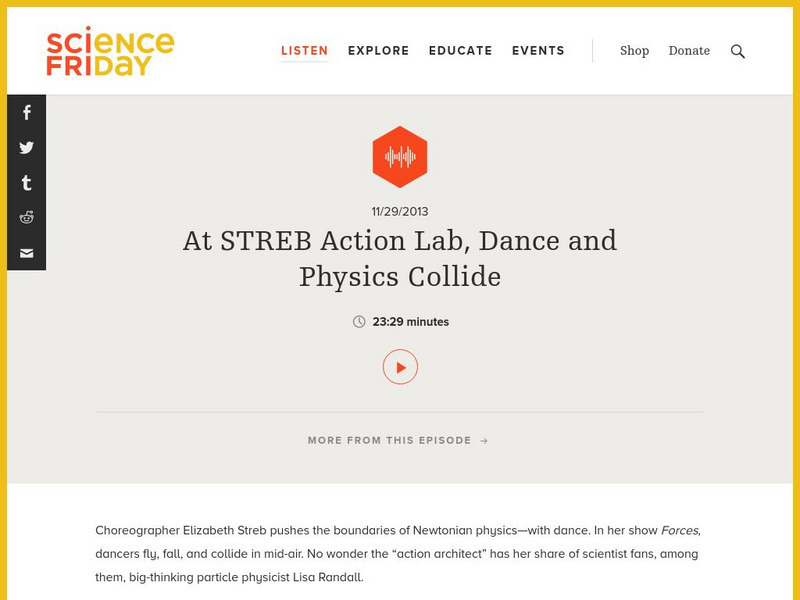Hi, what do you want to do?
National Science Foundation
National Science Foundation: Science of Nhl Hockey
A collection of ten videos that examine the physics behind NHL hockey. They cover topics such as Newton's Laws of Motion, projectile motion, and kinematics.
National Science Foundation
National Science Foundation: Science of Speed
A collection of videos that examine the physics concepts at play in NASCAR racing. They cover topics such as friction, tires, aerodynamics, balance, and the fire suits worn by drivers.
National Science Foundation
National Science Foundation: Science of the Winter Olympics: Aerial Physics
In the sport of freestyle aerials, skiers are judged on their ability to perform complex jumps in the air. Emily Cook, a 12-year veteran of the U.S. Freestyle team, and Paul Doherty, a Senior Scientist at the Exploratorium in San...
National Science Foundation
National Science Foundation: Science of the Winter Olympics: Slapshot Physics
One of the most popular team sports in the Winter Olympics is hockey. More than just a physical game, for scientists, it's a showcase for physics on ice - especially when it comes to the slapshot. Three-time Olympian Julie Chu, Thomas...
National Science Foundation
National Science Foundation: Science of the Winter Olympics: Figure Skating
Every four years, we watch the stakes for Olympic figure skaters get higher, as they try to increase rotation in the air with their triple axels and quadruple toe loops. How do they do that? It's a scientific principle that Olympic...
National Science Foundation
National Science Foundation: Science of the Winter Olympics: Science of Skates
The ice skates worn by hockey players, figure skaters and speed skaters are vastly different from what were once used. Melissa Hines, the Director of the Cornell University Center for Materials Research, and Sam Colbeck, a retired...
National Science Foundation
National Science Foundation: Science of the Winter Olympics: Blade Runners
Speed skating is all about force and movement - what, in physics, are known as Newton's First Three Laws of Motion. J.R. Celski, a U.S. speed skater, and physicist George Tuthill of Plymouth State University explain.
National Science Foundation
National Science Foundation: Science of the Winter Olympics: Banking on Speed
The winter games in Vancouver provided a chance for the United States' four-man bobsled team to win its first gold medal in more than 60 years. With the help of Paul Doherty, senior scientist at the Exploratorium in San Francisco,...
National Science Foundation
National Science Foundation: Science of the Winter Olympics: The Science of Skis
In skiing events like the downhill, slalom or ski jump, it's often the skis that are bound to an athlete's feet - and the materials used to make them - that give these athletes an edge over the competition. U.S. Ski Team members Julia...
National Science Foundation
National Science Foundation: Science of Winter Olympics: Science of Snowboarding
To get "max air" off the half-pipe without losing their balance, snowboarders might want to check out this experiment that Paul Doherty, a senior scientist at the Exploratorium in San Francisco, cooked up, using a skateboard and a glass...
National Science Foundation
National Science Foundation: Science of the Winter Olympics: Internal Athletes
Cross-country skiers are among the fittest athletes in the world. Deborah King, an associate professor in the Department of Exercise and Sports Sciences at Ithaca College and Joseph Francisco, president of the American Chemical Society,...
National Science Foundation
National Science Foundation: Science of the Winter Olympics: Science Friction
Curling has been in the Winter Olympics for a while now, but it still seems a little strange to most of us. John Shuster, the captain - or "skip" - of the U.S. Curling Team in the Vancouver Winter Olympics, explains this unusual sport,...
National Science Foundation
National Science Foundation: Science of the Winter Olympics: Competition Suits
Olympic athletes have long worn special competition clothing to gain an edge. Science and technology continue to improve on what they wear. Hear from Olympians Chad Hedrick, Steve Holcomb and Erin Hamlin, and Melissa Hines, the director...
National Science Foundation
National Science Foundation: Science of Nfl Football
A collection of ten videos that examine the physics and math behind NFL football. They cover topics such as Newton's Laws of Motion, the Pythagorean Theory, kinematics, and projectile motion.
National Science Foundation
National Science Foundation: Science of the Olympics: Engineering in Sports
A collection of 36 videos that examine the science behind different sports of the Olympics.
National Science Foundation
National Science Foundation: Science of the Winter Olympics
A collection of twenty six videos that examine the science behind different sports of the Winter Olympics.
National Science Foundation
National Science Foundation: Geometric Shapes: Spheres, Ellipses and Spheroids
Students learn about the science of NFL football. The video [4:10] discusses how the three-dimensional shape of a football helps an NFL quarterback throw a hard, accurate pass.
University of Nebraska
University of Nebraska Lincoln: Football Physics
Every Husker home game, Dr. Tim Gay attempts something as crazy as running against the NU defense: bringing physics to everyday life. In one-minute segments shown on the screens around the stadium, he talks about basic physics concepts...
National Science Foundation
National Science Foundation: Science of Nhl Hockey: Vectors
Explains why passing the puck in ice hockey is such an important skill. The puck is an example of a velocity vector and vectors can be added to determine the direction and speed of the puck. [4:28]
National Science Foundation
National Science Foundation: Science of Nhl Hockey: Work, Energy & Power
In order to generate a 100 mile-per-hour (160 kph) slapper, NHL players depend on three important physics concepts: work, energy and power. [5:15]
National Science Foundation
National Science Foundation: Science of Nhl Hockey: Reflexes & Reaction Time
An NHL goalie relies on his brain even more than his equipment in order to stop a puck with split-second timing. How a goalie does that is described in this video. [5:26]
National Science Foundation
National Science Foundation: Science of Nhl Hockey: Newton's Three Laws of Motion
Scientists explain how Newton's Three Laws of Motion manifest themselves in a game of hockey. [5:32]
National Science Foundation
National Science Foundation: Science of the Winter Olympics: Olympic Motion
Dan Fletcher, a bioengineer, studies the movement of cells in the human body. He explains that it is practice that causes muscles to organize themselves for peak performance in an athlete. [5:39]
Science Friday Initiative
Science Friday: At Streb Action Lab, Dance and Physics Collide
Choreographer and gravity-junkie Elizabeth Streb pushes the boundaries of Newtonian physics with dance.





















